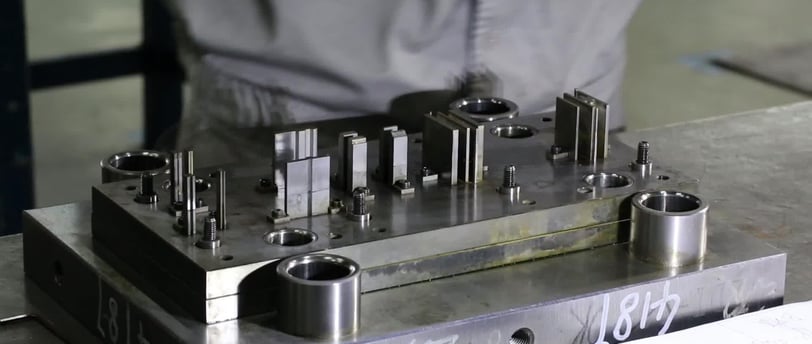Performance Testing and Quality Control of Stamping Dies
2/17/2025


Introduction to Stamping Dies
Stamping dies are specialized tools used in various manufacturing processes to shape and cut materials, predominantly metals. These devices play a crucial role in the production of components across multiple industries, including automotive, aerospace, and electronics. The primary function of stamping dies is to create precise, complex shapes and features in raw materials while maintaining efficiency and consistency in the production process.
There are several types of stamping dies commonly utilized in manufacturing, each serving distinct purposes. Progressive dies, for instance, are structured to perform multiple operations in a single pass. These dies advance a strip of metal through a series of stations, progressively shaping and cutting the material into its final form. Compound dies, on the other hand, combine two or more operations within one die set, allowing for more intricate designs and potentially reducing production time. Lastly, single-station dies are designed to carry out one operation at a time, making them ideal for simpler shapes or designs.
The importance of stamping dies cannot be overstated, as they directly influence both production efficiency and product quality. High-quality stamping dies lead to better fitting components, fewer defects, and less waste, all of which contribute to reduced production costs and enhanced operational workflows. Additionally, the use of stamping dies optimizes the manufacturing process by minimizing the need for secondary operations, thus saving both time and resources.
Given their pivotal role in the manufacturing landscape, it is vital to focus not only on the design and production of stamping dies but also on their performance testing and quality control. Ensuring that these dies operate at peak performance guarantees consistent output and enhances the overall quality of the finished products. This discussion sets the stage for understanding the subsequent importance of evaluating stamping die performance and the metrics that inform quality control processes.
Importance of Performance Testing
Performance testing is a crucial aspect of the overall quality control process for stamping dies. It plays a vital role in ensuring that the dies not only meet the design specifications but also perform effectively throughout their operational lifespan. By systematically assessing various performance metrics, such as durability, dimensional accuracy, and longevity, manufacturers can identify potential issues before they lead to defective products or costly operational disruptions.
Durability is an essential factor that impacts the performance of stamping dies. High-quality dies need to withstand repetitive stress and wear during production processes. Performance testing enables manufacturers to evaluate the resilience of the dies under various conditions, ensuring that they can maintain their functionality over time. Dimensional accuracy is equally significant, as it directly correlates to the quality of the stamped products. Inaccuracies can lead to poorly made components, resulting in increased waste and rework costs.
To achieve reliable testing outcomes, several methodologies are employed. Simulation techniques, for instance, allow for the prediction of how dies will perform under specific conditions without the immediate need for physical trials. This approach can save time and resources while optimizing the design process. Physical testing methods, on the other hand, involve direct examination of the dies over consecutive production runs to assess their behavior in real-world applications.
Moreover, real-time monitoring during production presents an additional layer of assessment that can capture unforeseen performance issues as they arise. This proactive approach not only facilitates immediate corrective actions but also aids in fine-tuning future die designs. Ultimately, the significance of performance testing lies in its ability to prevent defects, enhance quality, and lower operational costs, ensuring compliance with industry standards and contributing to the overall efficiency of the production process.
Quality Control Best Practices
Ensuring the quality of stamping dies is paramount in achieving optimal performance and longevity. Best practices in quality control focus on several key processes designed to uphold stringent manufacturing standards. One of the foremost techniques utilized is statistical quality control (SQC). SQC employs various statistical methods to monitor and control the production process, helping to identify variations and ensure that dies are consistently produced to required specifications. By analyzing data collected throughout the manufacturing stages, manufacturers can take corrective actions when necessary, enhancing both product quality and operational efficiency.
Additionally, rigorous inspection protocols are essential to maintaining quality standards in stamping die production. This involves multiple stages of inspection, including incoming material verification, in-process checks, and final product evaluations. Each die should undergo detailed inspections that measure dimensional accuracy, surface finish, and functional performance. For this purpose, advanced measuring tools and gauges are typically employed, allowing for precise evaluation against predefined criteria.
Documentation and traceability also play a critical role in quality control practices. Comprehensive records of the manufacturing process, including test results, inspections, and any deviations from standards, must be maintained. This documentation not only simplifies troubleshooting but also enhances product traceability in case of quality failures. Furthermore, implementing continuous improvement methods, such as Lean Manufacturing or Six Sigma, fosters an environment where teams actively seek ways to enhance processes and reduce waste.
Cohesion among cross-functional teams is vital for maintaining high quality throughout the stamping die production cycle. Collaboration among design, engineering, and manufacturing teams ensures that feedback is exchanged effectively, facilitating an ongoing dialogue about quality standards and best practices. Establishing this cooperative environment leads to better overall product quality and a reduction in defects, underscoring the significance of quality control in stamping die manufacturing.
Conclusion and Future Trends
Performance testing and quality control are integral components in the manufacturing of stamping dies, ensuring the accuracy, longevity, and efficiency of products. Throughout this blog post, we have examined various methodologies and practices that contribute to optimal die performance. From rigorous testing to continuous monitoring, businesses must implement these strategies to mitigate risks and enhance production quality.
Looking forward, the stamping die industry is poised for significant advancements driven by digital technology and automation. The integration of digital tools, such as real-time data analytics and machine-learning algorithms, allows manufacturers to assess the performance of their stamping dies with unprecedented precision. By harnessing these technologies, companies can identify inefficiencies and potential failures early in the production process, leading to improved operational efficiency and reduced downtime. Furthermore, the use of augmented reality for training and maintenance can enhance the skill set of operators, leading to higher quality outputs.
Additionally, the evolution of materials science is set to impact die design and performance in remarkable ways. Innovative materials and coatings can extend the lifespan of stamping dies and enhance their resistance to wear and tear, further improving cost-effectiveness. As manufacturers explore new approaches to die construction, they will need to focus on sustainability, balancing performance with environmental considerations.
It is crucial for industry stakeholders to remain informed about these emerging trends, as staying ahead of technological innovations can provide a competitive edge. By investing in research and development, and actively adopting new materials and technologies, organizations can enhance their production methods, optimize quality control processes, and ensure that their stamping dies meet or exceed the stringent industry standards.
